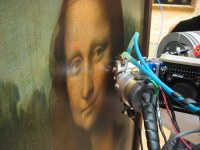 |
|
X-ray fluorescence spectrometry was done directly on the paintings in the Louvre Museum. Copyright: V.A. Solé/ESRF |
How did Leonardo da Vinci manage to paint such perfect faces? For the first time a quantitative chemical analysis has been done on seven paintings by da Vinci directly in the rooms of the Louvre Museum without extracting any samples. The analysis identifies the composition and thickness of each layer of material laid down by the painter. The results reveal that, in the case of glazes, thin layers of 1 to 2 micrometers have been applied. The study, led by Philippe Walter and a team from the Laboratoire du Centre de Recherche et de Restauration des Musées de France, with the collaboration of the European Synchrotron Radiation Facility (ESRF) and the support of the Louvre Museum, was published July 15 in the journal Angewandte Chemie, International Edition.
…
Add new comment